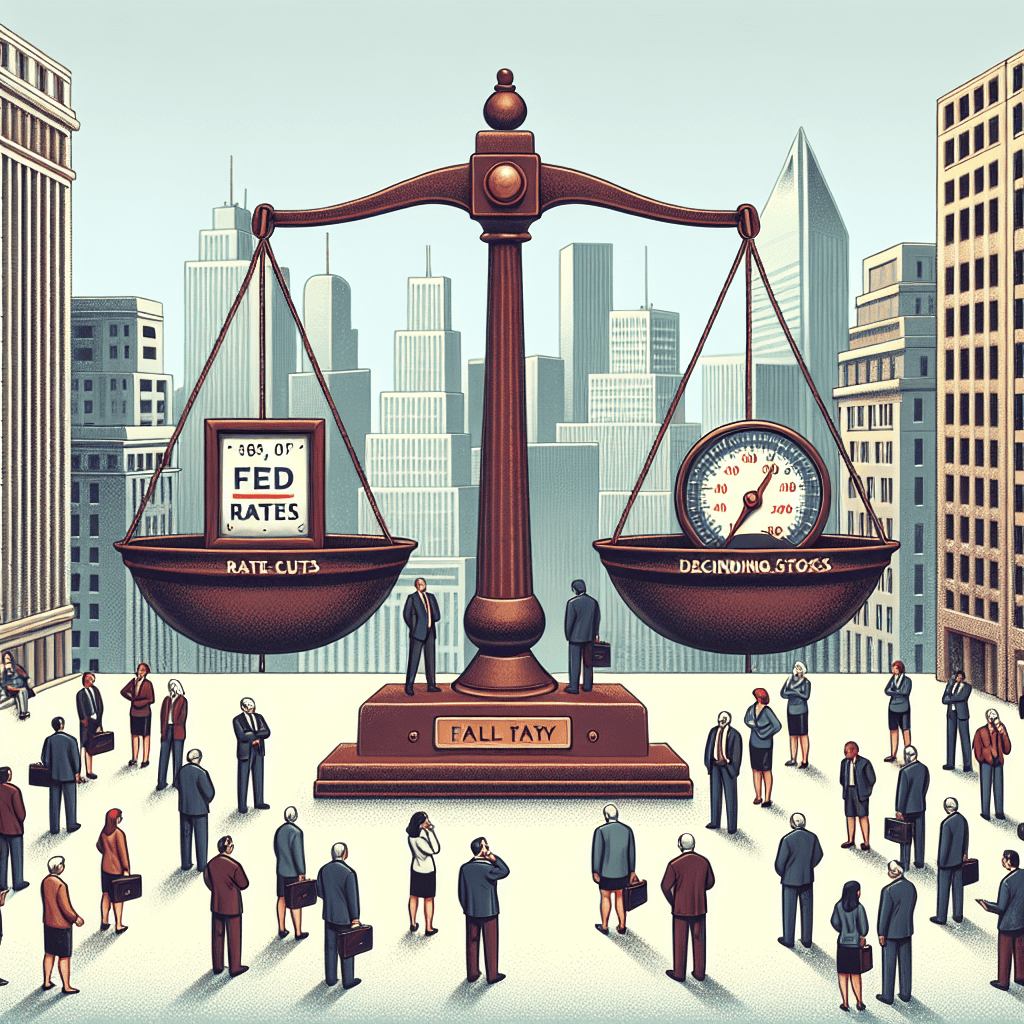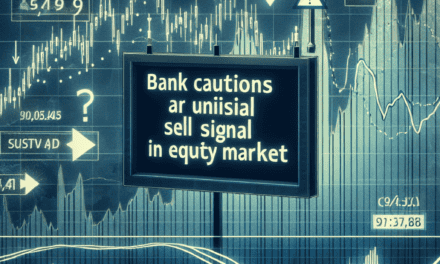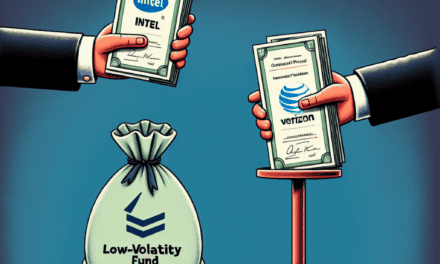“Market Jitters: Wall Street Eyes Fed Rate Cuts Amid Stock Slump”
Introduction
Wall Street is currently navigating a complex financial landscape as investors weigh the possibility of Federal Reserve interest rate cuts amid a backdrop of declining stock prices. The market’s recent downturn has prompted speculation about potential monetary policy adjustments, with stakeholders closely monitoring economic indicators and central bank signals. This environment of uncertainty has heightened attention on the Fed’s next moves, as market participants assess the implications of rate cuts on investment strategies and economic growth. The interplay between these factors is shaping a critical moment for financial markets, with significant implications for both short-term trading and long-term economic outlooks.
Impact Of Fed Rate Cuts On Wall Street’s Stock Performance
In recent months, Wall Street has been closely monitoring the Federal Reserve’s monetary policy decisions, particularly the potential for rate cuts, as stock markets experience a notable decline. The interplay between interest rates and stock performance is a critical aspect of financial markets, and understanding this relationship is essential for investors seeking to navigate the current economic landscape. As the Federal Reserve contemplates adjustments to its interest rate policy, the implications for Wall Street are multifaceted and warrant careful consideration.
To begin with, interest rates set by the Federal Reserve have a profound impact on the cost of borrowing for businesses and consumers alike. Lower interest rates typically reduce borrowing costs, encouraging businesses to invest in expansion and consumers to increase spending. This, in turn, can stimulate economic growth, which is generally favorable for stock markets. Consequently, when the Federal Reserve signals potential rate cuts, it often leads to increased optimism among investors, who anticipate a more conducive environment for corporate profitability and economic expansion.
However, the current scenario presents a more complex picture. While the prospect of rate cuts might traditionally be viewed as a positive development for stocks, the underlying reasons for such cuts are causing concern among investors. The Federal Reserve’s consideration of rate reductions is largely driven by signs of economic slowdown, both domestically and globally. Trade tensions, geopolitical uncertainties, and slowing growth in major economies have all contributed to a more cautious economic outlook. As a result, while rate cuts could provide a short-term boost to stock markets, they also underscore the challenges facing the broader economy.
Moreover, the effectiveness of rate cuts in stimulating economic activity is not guaranteed. With interest rates already at historically low levels, the Federal Reserve has limited room to maneuver. This raises questions about the potential impact of further rate reductions on economic growth and, by extension, stock performance. Investors are acutely aware of these limitations, which adds a layer of complexity to their decision-making processes. As they weigh the potential benefits of rate cuts against the broader economic context, market sentiment remains cautious.
In addition to these considerations, the reaction of different sectors to potential rate cuts is another factor influencing Wall Street’s performance. For instance, financial institutions, which typically benefit from higher interest rates through increased lending margins, may face pressure in a low-rate environment. Conversely, sectors such as real estate and utilities, which are more sensitive to borrowing costs, could see improved performance. This sectoral divergence adds another dimension to the market’s response to potential rate cuts, further complicating the investment landscape.
In conclusion, as Wall Street grapples with the implications of potential Federal Reserve rate cuts, the outlook for stock performance remains uncertain. While lower interest rates could provide a temporary boost to markets, the underlying economic challenges that necessitate such cuts cannot be ignored. Investors must carefully assess the broader economic context, sectoral dynamics, and the limitations of monetary policy as they navigate this complex environment. Ultimately, the interplay between Federal Reserve actions and stock market performance underscores the intricate relationship between monetary policy and economic health, highlighting the need for a nuanced approach to investment strategies in the current climate.
Analyzing The Relationship Between Interest Rates And Market Volatility
In recent months, the financial landscape has been marked by a notable decline in stock prices, prompting investors and analysts to closely examine the potential for Federal Reserve rate cuts. This scrutiny arises from the intricate relationship between interest rates and market volatility, a dynamic that has long influenced investment strategies and economic forecasts. As Wall Street grapples with these developments, understanding the interplay between these factors becomes crucial for stakeholders seeking to navigate the uncertain terrain of financial markets.
Interest rates, set by the Federal Reserve, serve as a critical tool for managing economic growth and inflation. When the Fed adjusts these rates, it sends ripples through the financial ecosystem, affecting everything from consumer borrowing costs to corporate investment decisions. Historically, lower interest rates have been associated with economic stimulus, as they reduce the cost of borrowing, thereby encouraging spending and investment. Conversely, higher rates are typically employed to curb inflation, albeit at the risk of slowing economic growth. This delicate balance underscores the importance of the Fed’s decisions in shaping market sentiment.
In the current context, the prospect of rate cuts has gained traction as a potential remedy for the recent stock market downturn. Investors are keenly aware that lower rates could provide a much-needed boost to equities by making alternative investments, such as bonds, less attractive. This shift in investor preference often leads to increased demand for stocks, driving prices upward. However, the relationship between interest rates and stock market performance is not always straightforward. While rate cuts can stimulate economic activity, they may also signal underlying economic weaknesses, such as slowing growth or rising unemployment, which could exacerbate market volatility.
Moreover, the anticipation of rate cuts can itself contribute to market fluctuations. As investors speculate on the Fed’s next move, market sentiment can swing dramatically, leading to increased volatility. This phenomenon is further compounded by the global nature of financial markets, where developments in one region can have far-reaching implications elsewhere. For instance, geopolitical tensions or economic slowdowns in major economies can influence the Fed’s decision-making process, adding another layer of complexity to the already intricate relationship between interest rates and market dynamics.
In light of these considerations, market participants are closely monitoring economic indicators and Fed communications for clues about future rate adjustments. Key data points, such as employment figures, inflation rates, and GDP growth, are scrutinized for signs of economic health or distress. Additionally, statements from Fed officials are parsed for any hints of policy shifts, as even subtle changes in language can have significant market implications. This heightened attention to detail underscores the interconnectedness of economic variables and their collective impact on market behavior.
As Wall Street continues to weigh the potential for Fed rate cuts amid declining stock prices, the broader implications for market volatility remain a focal point of analysis. While lower rates may offer a temporary reprieve for equities, the underlying economic conditions driving these decisions warrant careful consideration. Ultimately, the relationship between interest rates and market volatility is a multifaceted one, shaped by a myriad of factors that extend beyond the immediate realm of monetary policy. As such, investors and analysts must remain vigilant, adapting their strategies to the evolving financial landscape in order to effectively manage risk and capitalize on opportunities.
Historical Trends: How Fed Decisions Influence Stock Market Movements
The relationship between Federal Reserve decisions and stock market movements has long been a subject of keen interest for investors and analysts alike. Historically, the Federal Reserve’s monetary policy, particularly its decisions regarding interest rates, has played a pivotal role in shaping market dynamics. As Wall Street currently grapples with the possibility of future rate cuts amidst declining stock prices, it is instructive to examine how past Fed actions have influenced market behavior.
To begin with, the Federal Reserve’s primary tool for influencing the economy is the manipulation of interest rates. When the Fed raises rates, borrowing costs increase, which can dampen consumer spending and business investment. Conversely, when the Fed cuts rates, it typically aims to stimulate economic activity by making borrowing cheaper. This dual approach has historically had significant implications for the stock market. For instance, during periods of rate cuts, equities often experience upward momentum as investors anticipate improved corporate earnings due to lower financing costs and increased consumer spending.
However, the relationship between Fed rate decisions and stock market movements is not always straightforward. While rate cuts are generally perceived as positive for stocks, the context in which these cuts occur is crucial. If rate cuts are implemented in response to a weakening economy, the initial positive reaction in the stock market may be tempered by concerns over broader economic health. This was evident during the financial crisis of 2008 when aggressive rate cuts by the Fed were initially met with skepticism by investors wary of the underlying economic turmoil.
Moreover, historical trends suggest that the timing and communication of Fed decisions are equally important. The Federal Reserve’s ability to manage market expectations through clear communication has often been as influential as the rate changes themselves. For example, during the late 1990s, the Fed’s transparent communication strategy helped to mitigate market volatility, even as it navigated a series of rate adjustments. This highlights the importance of investor confidence in the Fed’s ability to steer the economy effectively.
In addition to these factors, the broader economic environment and geopolitical considerations also play a role in how Fed decisions impact the stock market. For instance, during periods of geopolitical uncertainty or trade tensions, the market’s response to Fed actions may be more muted, as investors weigh these external risks against domestic monetary policy changes. This interplay between domestic and international factors further complicates the relationship between Fed decisions and market movements.
As Wall Street currently contemplates the potential for future rate cuts, it is essential to consider these historical trends. While the prospect of lower rates may offer some relief to declining stock prices, the broader economic context and investor sentiment will ultimately shape the market’s response. Furthermore, the Fed’s communication strategy will be critical in managing expectations and ensuring that any policy shifts are perceived as part of a coherent strategy to support economic stability.
In conclusion, the historical relationship between Federal Reserve decisions and stock market movements underscores the complexity of monetary policy’s impact on financial markets. While rate cuts have often been associated with positive stock market performance, the broader economic context, timing, and communication of these decisions are equally important in determining their ultimate effect. As investors navigate the current landscape, these historical insights provide valuable context for understanding the potential implications of future Fed actions.
Investor Sentiment: Navigating Uncertainty Amidst Rate Cut Speculations

Investor sentiment has been a focal point of discussion as Wall Street grapples with the implications of potential Federal Reserve rate cuts amidst a backdrop of declining stock prices. The financial markets, known for their sensitivity to monetary policy signals, are currently navigating a complex landscape where economic indicators and central bank decisions are closely intertwined. As investors attempt to decipher the Federal Reserve’s next move, the prevailing uncertainty has led to a cautious approach in trading activities.
The recent decline in stock prices can be attributed to a confluence of factors, including concerns over economic growth, geopolitical tensions, and corporate earnings reports that have not met expectations. These elements have collectively contributed to a volatile market environment, prompting investors to reassess their portfolios and risk appetites. In this context, the prospect of Federal Reserve rate cuts has emerged as a potential catalyst for market stabilization, albeit with its own set of uncertainties.
Historically, rate cuts have been employed by the Federal Reserve as a tool to stimulate economic activity by making borrowing cheaper, thereby encouraging spending and investment. However, the current economic landscape presents a unique challenge. While some sectors of the economy exhibit signs of resilience, others are showing vulnerabilities that could be exacerbated by external shocks. Consequently, the Federal Reserve’s decision-making process is under intense scrutiny, as investors weigh the potential benefits of rate cuts against the risks of inflationary pressures and financial instability.
Moreover, the global economic environment adds another layer of complexity to the situation. With major economies experiencing varying degrees of growth and contraction, the interconnectedness of global markets means that any decision by the Federal Reserve will have far-reaching implications. Investors are particularly attuned to the potential ripple effects on currency valuations, trade balances, and international capital flows. As such, the anticipation of rate cuts is not only a domestic concern but also a global one, influencing investor sentiment across borders.
In light of these dynamics, market participants are adopting a more defensive stance, characterized by a shift towards safer assets such as government bonds and gold. This flight to safety reflects a broader trend of risk aversion, as investors seek to protect their capital amidst the prevailing uncertainty. At the same time, there is a growing interest in sectors that are perceived to be more resilient to economic downturns, such as healthcare and consumer staples. These strategic adjustments underscore the importance of diversification in navigating the current market environment.
As Wall Street continues to weigh the likelihood and timing of Federal Reserve rate cuts, communication from central bank officials will play a crucial role in shaping investor expectations. Clear and consistent messaging is essential to mitigate market volatility and foster confidence among investors. In this regard, the Federal Reserve’s upcoming meetings and statements will be closely monitored for any indications of policy shifts.
In conclusion, the interplay between investor sentiment and Federal Reserve rate cut speculations is a defining feature of the current market landscape. As Wall Street navigates this period of uncertainty, the focus remains on balancing the potential benefits of monetary easing with the inherent risks. Investors, armed with a keen awareness of the broader economic context, are poised to adapt their strategies in response to evolving market conditions.
Sector-Specific Reactions To Potential Fed Rate Adjustments
As Wall Street grapples with the implications of potential Federal Reserve rate cuts, sector-specific reactions have become a focal point for investors seeking to navigate the turbulent market landscape. The anticipation of monetary policy adjustments has historically influenced various sectors differently, and the current scenario is no exception. With stocks experiencing a decline, market participants are keenly observing how different industries might respond to the prospect of lower interest rates.
To begin with, the financial sector often finds itself at the forefront of discussions surrounding interest rate changes. Banks, in particular, are sensitive to rate adjustments due to their reliance on interest margins for profitability. A reduction in rates could compress these margins, potentially leading to decreased earnings. However, it is worth noting that lower rates might also stimulate borrowing, thereby increasing loan volumes and partially offsetting the negative impact on margins. Consequently, financial institutions are closely monitoring the Federal Reserve’s signals to adjust their strategies accordingly.
In contrast, the real estate sector typically benefits from lower interest rates, as they tend to reduce borrowing costs for both developers and homebuyers. This can lead to increased activity in the housing market, driving demand for residential and commercial properties. Real estate investment trusts (REITs), which often rely on debt financing, may also find the environment more favorable, as cheaper borrowing costs can enhance their investment capabilities and improve returns for investors. Thus, the real estate sector’s response to potential rate cuts is generally positive, with expectations of increased growth and investment opportunities.
Meanwhile, the technology sector presents a more nuanced picture. On one hand, lower interest rates can be advantageous for tech companies, particularly those in the growth phase, as they often depend on external financing to fund innovation and expansion. Reduced borrowing costs can facilitate access to capital, enabling these companies to invest in research and development more aggressively. On the other hand, the tech sector’s performance is also closely tied to consumer spending and business investment, both of which can be influenced by broader economic conditions. Therefore, while rate cuts may provide some relief, the overall impact on the technology sector will likely depend on a combination of factors, including consumer confidence and global economic trends.
The consumer goods sector, encompassing both discretionary and staple products, also exhibits varied reactions to potential rate adjustments. For consumer discretionary companies, lower interest rates can boost consumer spending by reducing the cost of credit, thereby increasing demand for non-essential goods and services. Conversely, consumer staples, which include essential products, may experience less direct impact from rate changes, as demand for these goods tends to remain stable regardless of economic conditions. Nevertheless, companies in this sector may still benefit from reduced borrowing costs, which can improve operational efficiency and profitability.
In summary, as Wall Street weighs the possibility of Federal Reserve rate cuts amidst declining stock prices, sector-specific reactions highlight the diverse ways in which different industries may be affected. Financial institutions brace for potential margin compression, while the real estate sector anticipates growth opportunities. The technology sector remains cautiously optimistic, balancing financing benefits with broader economic considerations. Meanwhile, consumer goods companies navigate the dual influences of consumer behavior and operational costs. As investors assess these dynamics, understanding the nuanced responses of each sector will be crucial in making informed decisions in an evolving market environment.
Comparing Global Market Responses To U.S. Fed Rate Policies
In recent months, the global financial landscape has been closely monitoring the actions of the U.S. Federal Reserve, particularly as Wall Street grapples with the implications of potential rate cuts. The Federal Reserve’s monetary policy decisions have long been a focal point for investors worldwide, given their significant influence on global markets. As stocks on Wall Street experience a decline, the anticipation of rate cuts has sparked varied responses across international markets, each reacting in accordance with their unique economic contexts and dependencies on U.S. economic health.
To begin with, the U.S. Federal Reserve’s consideration of rate cuts is primarily driven by a need to stimulate economic growth amid signs of a slowing economy. Lower interest rates typically encourage borrowing and investment, which can help bolster economic activity. However, the prospect of such cuts has led to a mixed reaction on Wall Street. While some investors view rate cuts as a necessary measure to sustain economic momentum, others express concern that these cuts may signal deeper economic troubles. Consequently, this uncertainty has contributed to the recent decline in U.S. stock markets, as investors weigh the potential benefits against the risks.
Transitioning to the global stage, the response to the Fed’s potential rate cuts varies significantly across different regions. In Europe, for instance, markets have shown a cautious optimism. The European Central Bank (ECB) has been navigating its own set of economic challenges, including sluggish growth and low inflation. As such, the prospect of U.S. rate cuts is seen as a potential catalyst for European markets, offering a glimmer of hope for increased trade and investment flows. However, European investors remain wary of the broader implications for global economic stability, which could offset any short-term gains.
Meanwhile, in Asia, the response has been more nuanced. In countries like China and Japan, where economic growth is heavily intertwined with U.S. economic performance, the potential for Fed rate cuts is met with a degree of apprehension. On one hand, lower U.S. rates could lead to a weaker dollar, which might benefit Asian exports by making them more competitive. On the other hand, there is concern that such cuts could exacerbate existing trade tensions and lead to increased volatility in currency markets. This duality reflects the complex interdependencies that characterize modern global trade relationships.
Furthermore, emerging markets present another layer of complexity in the global response to U.S. Fed policies. These markets often rely on foreign investment to fuel growth, and changes in U.S. interest rates can have profound effects on capital flows. A reduction in U.S. rates could lead to increased investment in emerging markets as investors seek higher returns. However, these markets also face the risk of capital flight if global economic conditions deteriorate, underscoring the delicate balance they must maintain.
In conclusion, the global market responses to potential U.S. Fed rate cuts are as diverse as they are interconnected. While Wall Street’s decline reflects a cautious approach to the Fed’s monetary policy, international markets are navigating their own sets of challenges and opportunities. As the world continues to watch the Federal Reserve’s next moves, the interplay between these global responses will undoubtedly shape the future of international economic dynamics. The intricate web of dependencies and reactions highlights the importance of understanding not only domestic economic policies but also their far-reaching global implications.
Strategies For Investors During Periods Of Monetary Policy Shifts
In the ever-evolving landscape of financial markets, investors are constantly seeking strategies to navigate periods of monetary policy shifts. As Wall Street grapples with the implications of potential Federal Reserve rate cuts, the stock market has experienced notable declines, prompting investors to reassess their portfolios and strategies. Understanding the dynamics of monetary policy and its impact on the market is crucial for making informed investment decisions during such times.
Monetary policy, particularly interest rate adjustments by the Federal Reserve, plays a pivotal role in shaping economic conditions. When the Fed signals potential rate cuts, it often aims to stimulate economic growth by making borrowing cheaper, thereby encouraging spending and investment. However, the anticipation of such moves can lead to volatility in the stock market, as investors weigh the potential benefits against the risks. In this context, developing a robust investment strategy becomes essential.
One approach investors might consider is diversifying their portfolios to mitigate risk. Diversification involves spreading investments across various asset classes, such as stocks, bonds, and commodities, to reduce exposure to any single market segment. During periods of monetary policy shifts, certain sectors may outperform others. For instance, rate cuts can benefit interest-sensitive sectors like real estate and utilities, as lower borrowing costs can enhance profitability. Conversely, financial stocks might face pressure due to narrower interest margins. By diversifying, investors can balance potential gains and losses across different sectors.
Moreover, maintaining a long-term perspective is crucial during times of market uncertainty. While short-term fluctuations can be unsettling, historical data suggests that markets tend to recover over time. Investors who remain focused on their long-term goals are better positioned to weather temporary downturns. This approach requires discipline and patience, as it involves resisting the urge to make impulsive decisions based on short-term market movements.
In addition to diversification and a long-term outlook, investors should also consider the role of fixed-income securities in their portfolios. Bonds, particularly those with longer maturities, can provide stability and income during periods of market volatility. As interest rates decline, bond prices typically rise, offering potential capital appreciation. However, it is important to assess the credit quality and duration of bonds to ensure they align with one’s risk tolerance and investment objectives.
Furthermore, staying informed about economic indicators and central bank communications is vital for making strategic investment decisions. Economic data releases, such as employment figures and inflation rates, can provide insights into the Fed’s future actions. Additionally, statements from Federal Reserve officials can offer clues about the direction of monetary policy. By staying informed, investors can anticipate potential market reactions and adjust their strategies accordingly.
Finally, consulting with financial advisors can provide valuable guidance during periods of monetary policy shifts. Advisors can offer personalized insights based on an individual’s financial situation and goals, helping to tailor investment strategies that align with changing market conditions. Their expertise can be particularly beneficial in navigating complex market environments and identifying opportunities that may arise from policy changes.
In conclusion, as Wall Street weighs the implications of potential Fed rate cuts amid declining stocks, investors must adopt strategies that account for the uncertainties of monetary policy shifts. By diversifying portfolios, maintaining a long-term perspective, incorporating fixed-income securities, staying informed, and seeking professional advice, investors can better position themselves to navigate the challenges and opportunities that arise during such periods. Through careful planning and informed decision-making, investors can strive to achieve their financial objectives even in the face of market volatility.
Q&A
1. **What is the current sentiment on Wall Street regarding Federal Reserve rate cuts?**
Wall Street is weighing the possibility of Federal Reserve rate cuts as a response to economic conditions and declining stock markets.
2. **How are stocks performing in the current market environment?**
Stocks are experiencing a decline, contributing to the discussions about potential rate cuts.
3. **What factors are contributing to the decline in stock markets?**
Economic uncertainties, inflation concerns, and potential impacts of monetary policy are contributing to the decline.
4. **How might Federal Reserve rate cuts impact the stock market?**
Rate cuts could potentially stimulate economic activity and boost investor confidence, leading to a recovery in stock prices.
5. **What are investors’ expectations regarding future Federal Reserve actions?**
Investors are speculating on the timing and magnitude of potential rate cuts by the Federal Reserve.
6. **How do interest rates influence stock market performance?**
Lower interest rates generally reduce borrowing costs for companies and consumers, potentially leading to increased spending and investment, which can positively impact stock markets.
7. **What are the potential risks of Federal Reserve rate cuts?**
Risks include the possibility of fueling inflation, reducing the Fed’s ability to respond to future economic downturns, and creating asset bubbles.
Conclusion
Wall Street is currently evaluating the possibility of Federal Reserve interest rate cuts in response to declining stock market performance. The anticipation of rate cuts suggests that investors are concerned about economic growth and are looking for monetary policy adjustments to stimulate the market. The decline in stocks reflects broader uncertainties and potential vulnerabilities in the economy, prompting market participants to closely monitor the Fed’s actions and statements for indications of future policy direction. Overall, the situation underscores the delicate balance the Fed must maintain between supporting economic growth and managing inflationary pressures.





